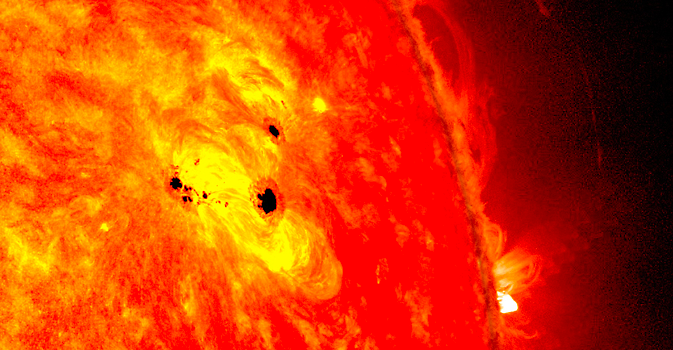The pair of sunspots which have now merged are each roughly the same diameter as the Earth
A large sunspot has appeared on the surface of the Earth‘s star and is thought to be growing at an exponential rate.
The sunspot – a phenomena which appears as a black speck and essentially indicates where the temperature is smaller than the surrounding surface area – was only a relatively mall blip just a few days ago.
However, it appears the sunspot designated AR3085 has now grown more than ten times in size in the space of two days, according to SpaceWeather.com. Moreover, having merged into another sunspot, it is now pointing almost directly at the Earth, meaning the planet could be blasted with significant levels of solar energy in the coming days.
For context, not only can solar flares have a significant impact on our atmosphere but each of these sunspots are almost the same size as the diameter of the Earth itself, both possessing a strong magnetic field.
SpaceWeather.com have already reported that a number of flares have been detected “crackling” around the spots. While only C-class flares have been emitted so far – one of the weaker classifications which don’t typically have a noticeable impact on the Earth – there is still caution among astronomers and weather experts.
The weakest three tiers of solar flares that government satellites track. A, B and C-class flares. M-class flares are more powerful and capable of causing radio blackouts at high altitudes; meanwhile, X-class flares are the strongest known to man and can cause widespread blackouts, damage to satellites and can even knock out ground-based power grids, according to NASA.
With that in mind, while the spots are manageable now, they could cause significant problems should they continue to grow – especially having already done so at such an alarming rate.
Sunspots and solar flares have become more frequent in recent years and are linked to the sun’s 11-year cycle of activity, which transitions between periods of high and low sunspot density every decade or so.
The next peak, referred to by scientists as a ‘solar maximum’, is due to occur some time in 2025. It is thought with as many as 115 sunspots could emerge on the sun’s surface during this time.
Related links
- Scientists discover nearby planet that is almost entirely covered in water
- Police seize record two tonnes of crystal meth worth $1.6 billion
- People spot ‘glitch in the matrix’ as plane stops mid-flight and left floating in the sky
















































